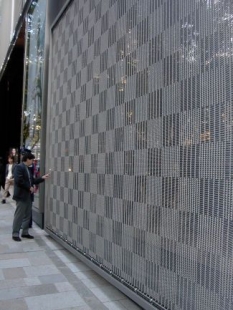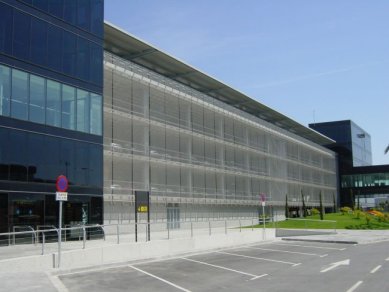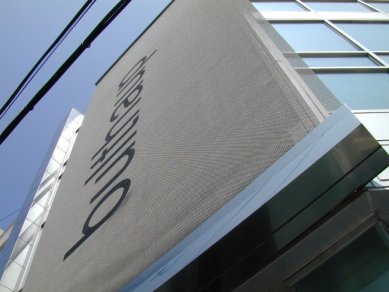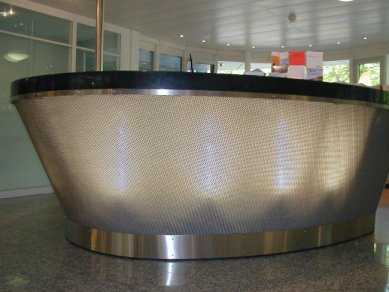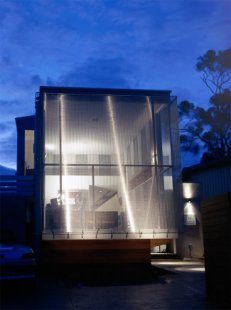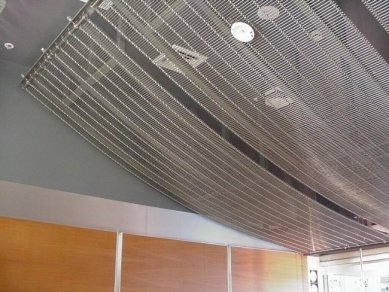
CreativeWEAVE
Functionality and aesthetics - key properties that characterize both quality architecture and metallic fabrics. The idea that connects one with the other was therefore a matter of time. Industrially used materials provide builders with proven techniques, accuracy, and robustness as a reliable parameter. On the other hand, they limit architects' space for personal interpretation and unexpected appearance. Metallic fabrics offer a backdrop of possibilities that no other material can provide: flexible, moldable, tensionable due to their textile structure, load-bearing, easy to maintain, and individually customizable thanks to the metallic materials used. Dimensions manufacturable at GKD - Gebr. Kufferath AG conform to any architecture; entire spaces can be enveloped without "seams" or connecting elements.
The path to architecture: steel fabric becomes "visible"
Turbulence screens for air ducts in the aerospace industry, microporous filters for medical technology, or tear, break, and high-temperature resistant conveyor belts in industry. Until 1992, these were metallic and plastic fabrics from GKD - successful products for the eyes of distant sectors of filtration technology and conveyor belt technology. Until then, the use of technical fabrics was limited only to their use in lining heating elements with aluminum fabrics.
In 1993, French architect Dominique Perrault was seeking a partner to realize his vision: to develop a metallic fabric to envelop a building while meeting all technical possibilities and requirements set by designers and metal-processing companies.
Already during the first project, the French National Library, GKD, together with Dominique Perrault, discovered a whole range of possibilities where and how to use metallic fabrics: a total of 12 different applications with an overall area of 30,000 m². After this pilot project, the use of CREATIVE WEAVE in architecture established itself at breathtaking speed.
Today, GKD is a world leader in the production of metallic fabrics for architecture and design. The reference list includes the most significant architects in the world and famous buildings on all continents. In addition to Dominique Perrault, names such as Paul Andreu, Jean Nouvel, Christian de Portzamparc, Andrée Putman, William Alsop, Norman Foster, Nicholas Grimshaw, Richard Rogers, David Chipperfield, Ricardo Bofill, Enric Miralles, Benedetta Tagliabue, Rafael Moneo, Meinhard von Gerkan, Hermann Tilke, Jan Störmer, Massimiliano Fuksas, Mario Bellini, Arata Isozaki, Jun Aoki, Helmut Jahn, Frank Gehry, Hans Hollein, Mario Botta, Lars Spuybroek, and a great many other outstanding architects are included here.
Know-how: heritage of the company's history
Unprecedented innovative competencies and consistency in an unusually thinking company have shaped the company’s history from the very beginning. The weaving mill for metallic materials, established in 1925 and run by its owners, has developed into an international leading company in the field. Demands for economical filtration media and conveyor belts led to high-tech products whose properties have proven themselves even in architecture. States where metallic fabrics up to 8 meters in width have been manufactured for decades furthermore demonstrate one of GKD's most important advantages: usable dimensions.
Proximity to customers: the driving force and success factor
Pure serial production has never been at the forefront of the business vision. Efforts for technological growth, consistent uncovering of sales areas, and above all, proximity to customers and a complete service orientation led to the successful establishment of three autonomous and efficient business units: mesh and filtration technology, conveyor and process belts, as well as architecture and design. A large number of decisive innovations in the field of metallic fabrics come from GKD. Worldwide, it now employs more than 600 collaborators, of which 380 are in Düren.
Combination of beauty and intelligence
The aesthetics of stainless fabrics were the first impulse for their use in architecture and design. In addition to Dominique Perrault, Helmut Jahn is also among the architects who have intensively dealt with fabrics for use in architecture and brought them to their current significance. The facade of the parking garage at Cologne/Bonn Airport, developed by Helmut Jahn, set the direction for many similar buildings.
Over time, it became increasingly apparent that beyond decorative effects, the technical properties of the fabrics also convince architects, designers, and metal-processing companies. This includes the ability, thanks to an 8-meter width and almost endless length, to envelop large surfaces in two or three dimensions without visible connections.
Another milestone in the use of fabrics in architecture is the facade of the Bertelmann Pavilion “Planet-m”, where it was possible for the first time to seamlessly “wrap” a round object.
Durability, fire resistance, easy maintenance, recyclability, robust protection against rain, wind, and sun - these are properties that modern Facility Management requires. The material prepared for installation is easy to maintain, as is the planning, installation, and working with it.
Endless horizons of application
The characteristic of the success of fabrics in the market is not only large objects but especially countless technical successes and knowledge that have been achieved together with architects and metal-processing companies around the world.
Today, GKD offers a wide selection of fabrics developed for architecture for various applications.
Kovárna 3000
solutions for blacksmiths and locksmiths
Nepřívěc 3
50601 Jičín
tel.: 493 57 37 20
fax.: 493 57 37 21
mobile: 777 726 367
www.kovarna3000.cz
gkd.kovarna3000.cz
The path to architecture: steel fabric becomes "visible"
Turbulence screens for air ducts in the aerospace industry, microporous filters for medical technology, or tear, break, and high-temperature resistant conveyor belts in industry. Until 1992, these were metallic and plastic fabrics from GKD - successful products for the eyes of distant sectors of filtration technology and conveyor belt technology. Until then, the use of technical fabrics was limited only to their use in lining heating elements with aluminum fabrics.
 |
In 1993, French architect Dominique Perrault was seeking a partner to realize his vision: to develop a metallic fabric to envelop a building while meeting all technical possibilities and requirements set by designers and metal-processing companies.
Already during the first project, the French National Library, GKD, together with Dominique Perrault, discovered a whole range of possibilities where and how to use metallic fabrics: a total of 12 different applications with an overall area of 30,000 m². After this pilot project, the use of CREATIVE WEAVE in architecture established itself at breathtaking speed.
Today, GKD is a world leader in the production of metallic fabrics for architecture and design. The reference list includes the most significant architects in the world and famous buildings on all continents. In addition to Dominique Perrault, names such as Paul Andreu, Jean Nouvel, Christian de Portzamparc, Andrée Putman, William Alsop, Norman Foster, Nicholas Grimshaw, Richard Rogers, David Chipperfield, Ricardo Bofill, Enric Miralles, Benedetta Tagliabue, Rafael Moneo, Meinhard von Gerkan, Hermann Tilke, Jan Störmer, Massimiliano Fuksas, Mario Bellini, Arata Isozaki, Jun Aoki, Helmut Jahn, Frank Gehry, Hans Hollein, Mario Botta, Lars Spuybroek, and a great many other outstanding architects are included here.
Know-how: heritage of the company's history
Unprecedented innovative competencies and consistency in an unusually thinking company have shaped the company’s history from the very beginning. The weaving mill for metallic materials, established in 1925 and run by its owners, has developed into an international leading company in the field. Demands for economical filtration media and conveyor belts led to high-tech products whose properties have proven themselves even in architecture. States where metallic fabrics up to 8 meters in width have been manufactured for decades furthermore demonstrate one of GKD's most important advantages: usable dimensions.
Proximity to customers: the driving force and success factor
Pure serial production has never been at the forefront of the business vision. Efforts for technological growth, consistent uncovering of sales areas, and above all, proximity to customers and a complete service orientation led to the successful establishment of three autonomous and efficient business units: mesh and filtration technology, conveyor and process belts, as well as architecture and design. A large number of decisive innovations in the field of metallic fabrics come from GKD. Worldwide, it now employs more than 600 collaborators, of which 380 are in Düren.
Combination of beauty and intelligence
The aesthetics of stainless fabrics were the first impulse for their use in architecture and design. In addition to Dominique Perrault, Helmut Jahn is also among the architects who have intensively dealt with fabrics for use in architecture and brought them to their current significance. The facade of the parking garage at Cologne/Bonn Airport, developed by Helmut Jahn, set the direction for many similar buildings.
Over time, it became increasingly apparent that beyond decorative effects, the technical properties of the fabrics also convince architects, designers, and metal-processing companies. This includes the ability, thanks to an 8-meter width and almost endless length, to envelop large surfaces in two or three dimensions without visible connections.
 |
Another milestone in the use of fabrics in architecture is the facade of the Bertelmann Pavilion “Planet-m”, where it was possible for the first time to seamlessly “wrap” a round object.
Durability, fire resistance, easy maintenance, recyclability, robust protection against rain, wind, and sun - these are properties that modern Facility Management requires. The material prepared for installation is easy to maintain, as is the planning, installation, and working with it.
Endless horizons of application
The characteristic of the success of fabrics in the market is not only large objects but especially countless technical successes and knowledge that have been achieved together with architects and metal-processing companies around the world.
Today, GKD offers a wide selection of fabrics developed for architecture for various applications.
Kovárna 3000
solutions for blacksmiths and locksmiths
Nepřívěc 3
50601 Jičín
tel.: 493 57 37 20
fax.: 493 57 37 21
mobile: 777 726 367
www.kovarna3000.cz
gkd.kovarna3000.cz
The English translation is powered by AI tool. Switch to Czech to view the original text source.
